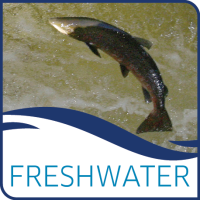The Girnock and Baddoch catchments are long-term monitoring sites where the population dynamics of spring salmon have been assessed since 1966 and 1988 respectively. These sites include a pair of fixed traps designed to catch emigrating juvenile salmon and returning adults. Trap protocols were similar, although not identical, over the monitoring period. This dataset provides counts of adult Atlantic salmon that have returned to the trap sites separated by sex and sea age for the duration of the monitoring period at each site. Annual sex ratios for 1SW and maiden MSW returners are reported. In addition, estimated total ova stock and recruits are reported by spawning year. Recruit ova estimates for each spawner year are subsequently reported separated by their return year.
Data and Resources
- Girnock and Baddoch: Adult Atlantic Salmon Return to Traps by Sex and Sea Age, Sex Ratios and Ova to Ova Stock-Recruitment Datasetcsv
Site – Name of the trap site
Preview Download
Year(Y) – Year of spawning that ties...
| Field | Value |
|---|---|
| Publisher | |
| Modified | 2023-03-03 |
| Release Date | 2023-03-03 |
| Identifier | 2658d3ee-dc92-4bd6-a9c4-70b97eb07fa9 |
| Spatial / Geographical Coverage Area | POLYGON ((-3.4620666503906 56.910548648312, -3.4620666503906 57.06019678457, -3.0335998535156 57.06019678457, -3.0335998535156 56.910548648312)) |
| Temporal Coverage | 1966-01-01 to 2022-12-31 |
| Language | English (United Kingdom) |
| License | UK Open Government Licence (OGL) |
| Data Dictionary | Annual adult Atlantic salmon counts have been recorded at the Girnock and Baddoch traps since 1966 and 1988 respectively. This dataset reflects validated data recorded in MSS FishObs database. Individuals are sexed based on the presence of sexually dimorphic characteristics. Sea and freshwater ages are determined via scale reading (where possible) by multiple experienced specialists. Counts reflect the number of individual adult fish that are captured at the traps in each spawner year for each sex. These are subsequently separated by sea age . Adult count data include all individuals returning to the traps regardless of whether they spawned above the traps. One individual is recorded in both 1982 and 1987 without an allocated sex, these individuals were assumed to be males. No males were scaled at the Girnock in 1966. Sex ratios are reported for one sea winter fish (1SW; sea age 1) and maiden multiple sea winter fish (MSW; sea age 2 & 3), as the proportion of the years count that were female. Separate sex ratios are not provided for sea age 2 and older year classes or repeat spawners, as sample sizes are typically low with a high prevalence of 0 counts. No sex ratios are reported for 1966, as no male fish were aged. Ova deposition from individual females was estimated using the length-fecundity relationship (Bacon et al., 2012, DOI:10.1111/j.1095-8649.2012.03311.x) for upland early running salmon. A single female at the Girnock had no recorded length, so a mean length was estimated from females of the same age returning in the same year. Female salmon were considered to have contributed ova to in-stream production (stock) where they arrived at the traps containing appreciable numbers of eggs and were put above the traps. The dataset does not differentiate between stocked and unstocked ova as previous work suggests no difference in outcomes by smolt life-stage (Bacon et al, 2015, DOI: 10.1080/00028487.2015.1017655). Where sea age, freshwater age, or both are unknown, ages were assigned based on the proportions of freshwater / sea age combinations for returning females in each year. Estimated stock ova deposition and recruit ova deposition are provided as totals per spawner year (Y). Total ova deposition (stock) was estimated by summing the estimated ova content of individual females in each year that contributed to spawning. Total ova recruitment was estimated by summing the estimated ova content of individual females that returned to the traps lagged to the year they were spawned (regardless of whether they subsequently contributed to spawning or not). Individuals were only considered to contribute to recruit ova production if they naturally reached the trap sites. Thus some individuals that contributed to stock above the traps but were captured elsewhere (e.g. one year at the Baddoch where ova were used in an experiment to investigate fry dispersal via genetic methods) are excluded. The year of spawning for returning females (i.e. recruitment ova) was calculated from scale read ages with appropriate lags. Subsequently ova recruitment associated with a given spawner year are separated into individual cohorts reflecting their return year. No fish were allowed to spawn naturally above the Girnock trap in 1978. As such, there are no data available for this year. The dataset is reported up to spawning year 2015 to include adult returns with a total age of up to 6 years (3.3). The dataset contains some repeat spawning females (n = 51), these are included in calculations and counts unless clearly stated in this metadata. These fish could be represented in multiple spawning years data, depending upon if they spawn above the traps in one or more of their spawning years. This dataset does not differentiate between such individuals. It is assumed that the length-fecundity relationship for repeat spawners is the same as for maiden spawning fish. |
| Contact Name | Marine Scotland |
| Contact Email | |
| Public Access Level | Public |


